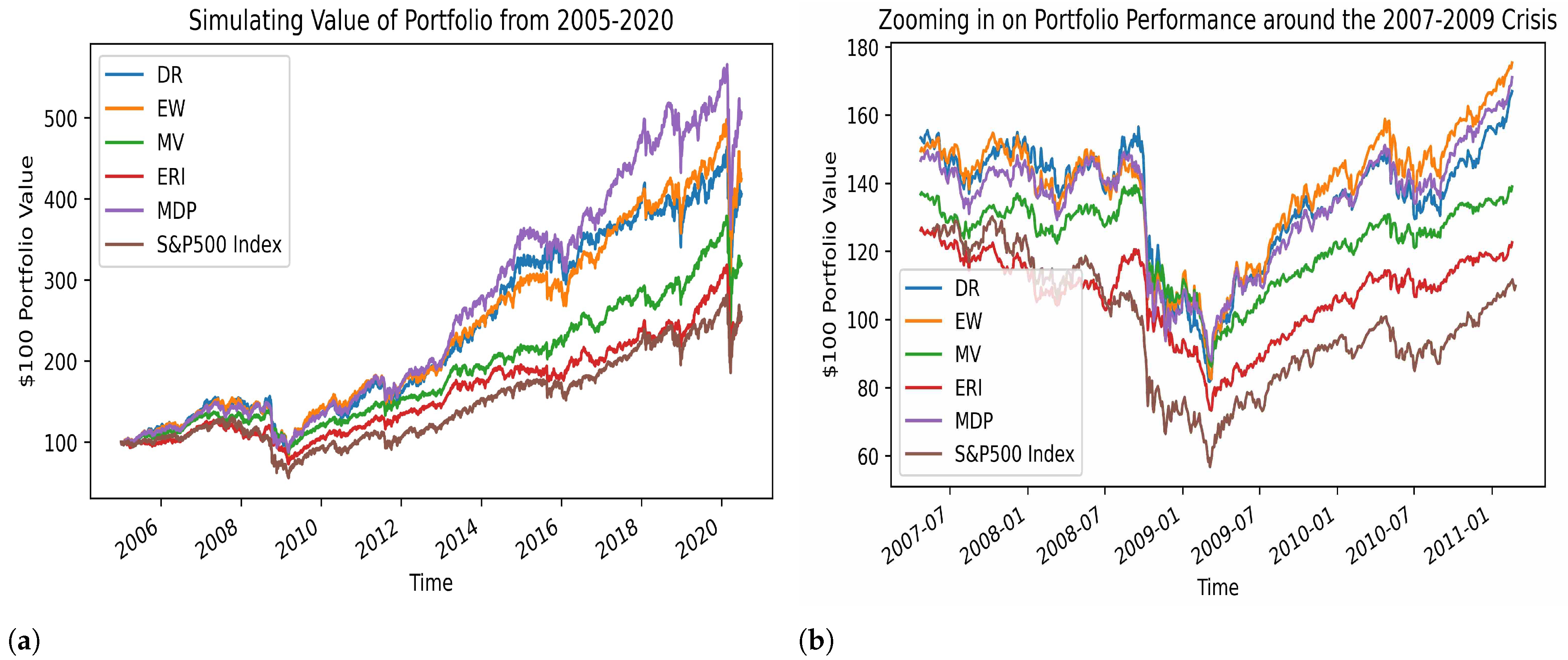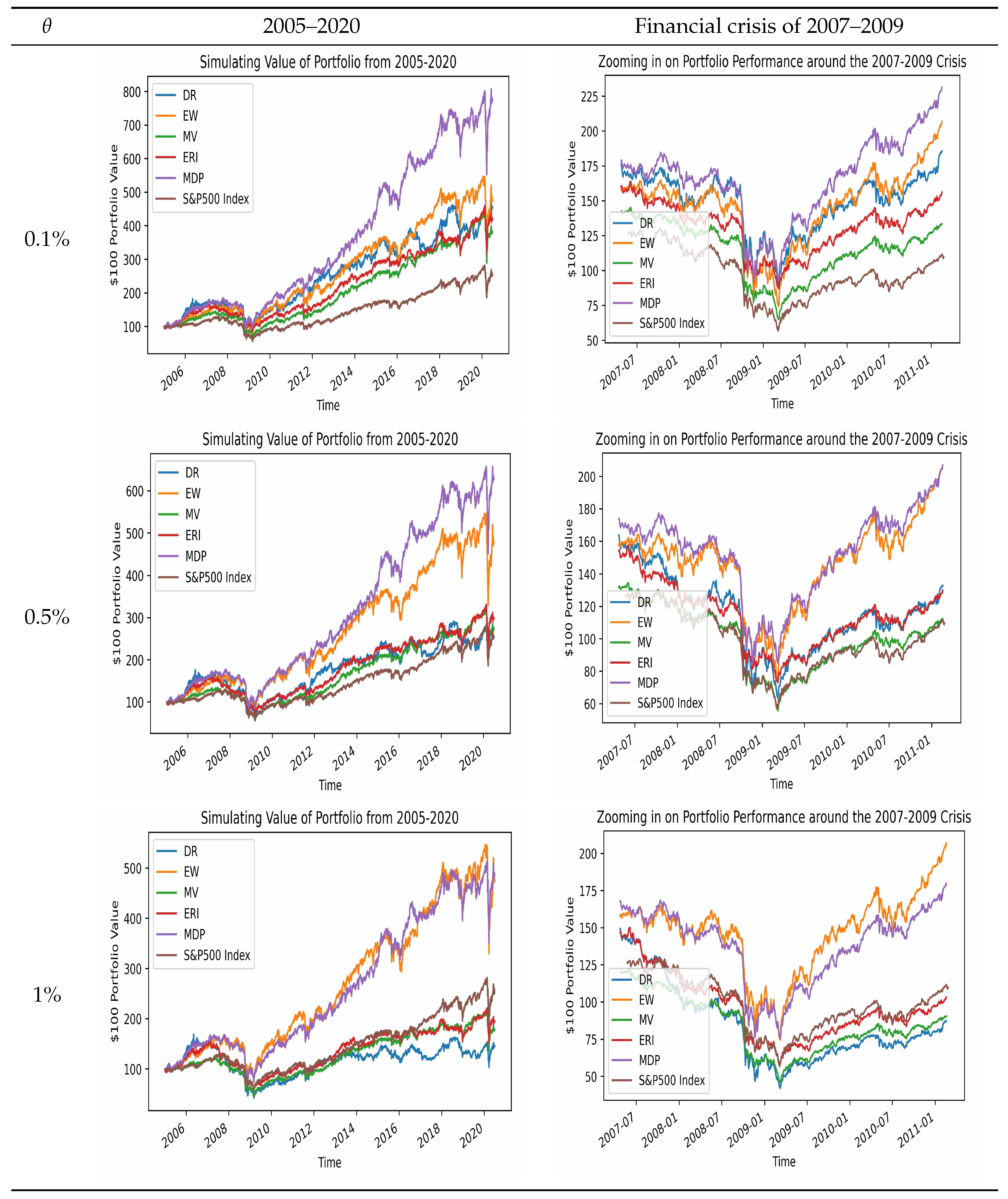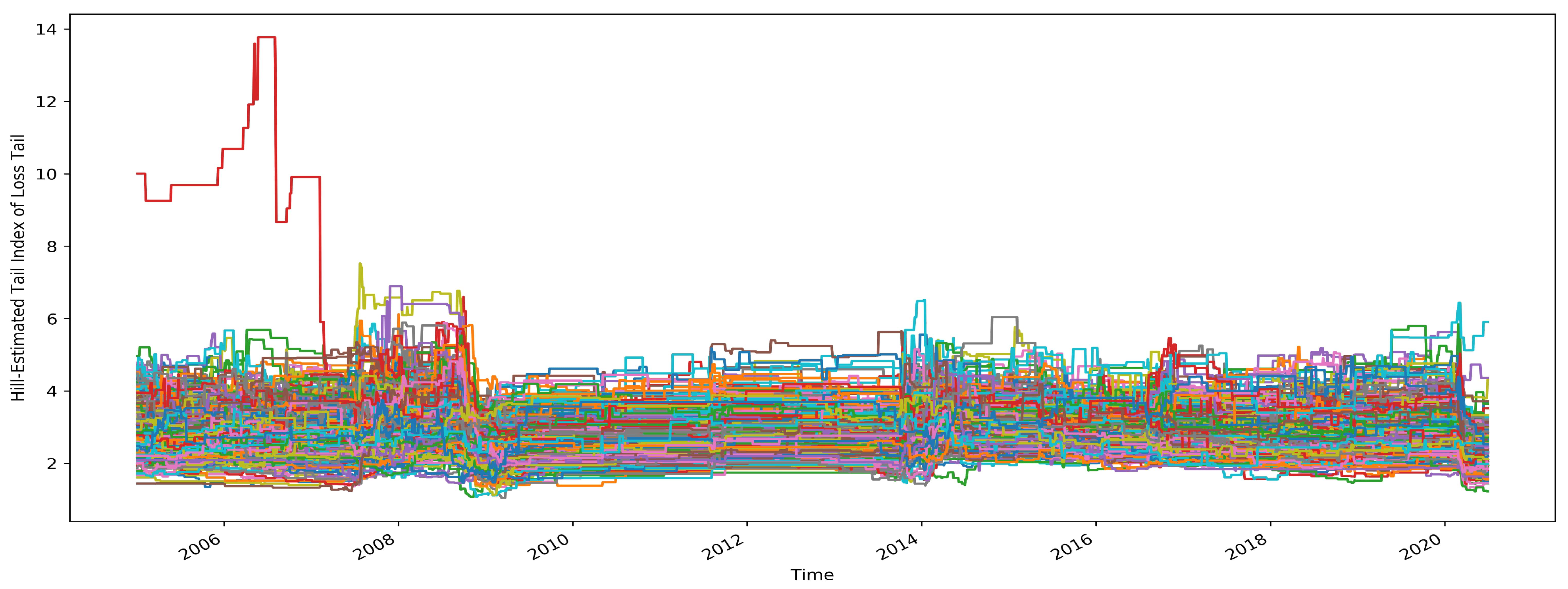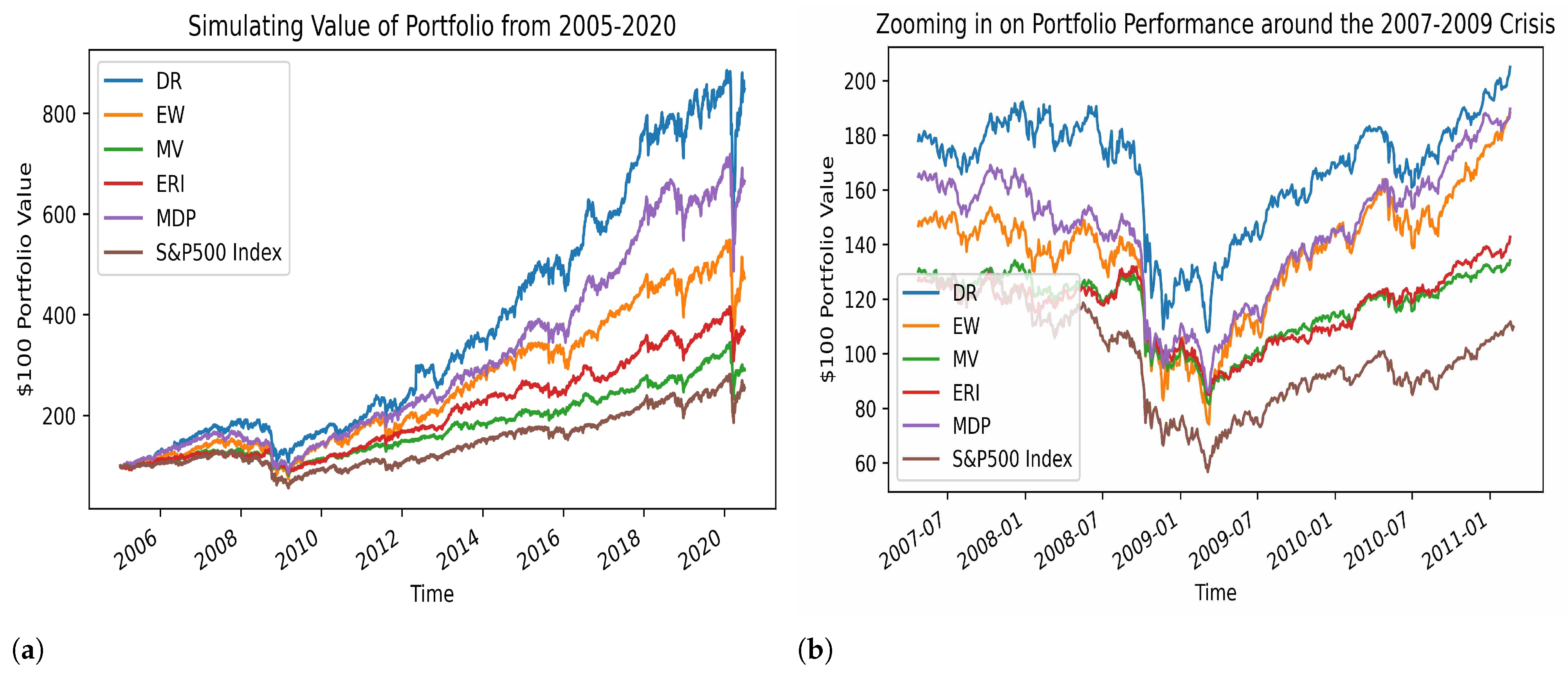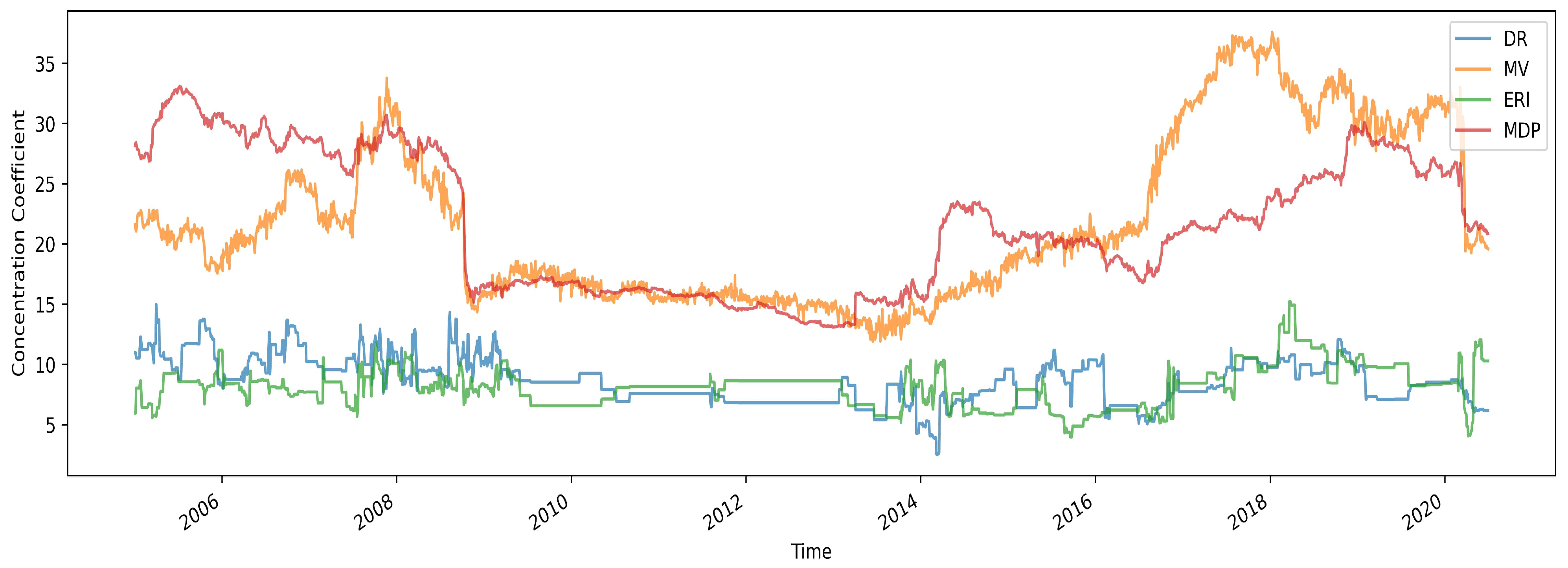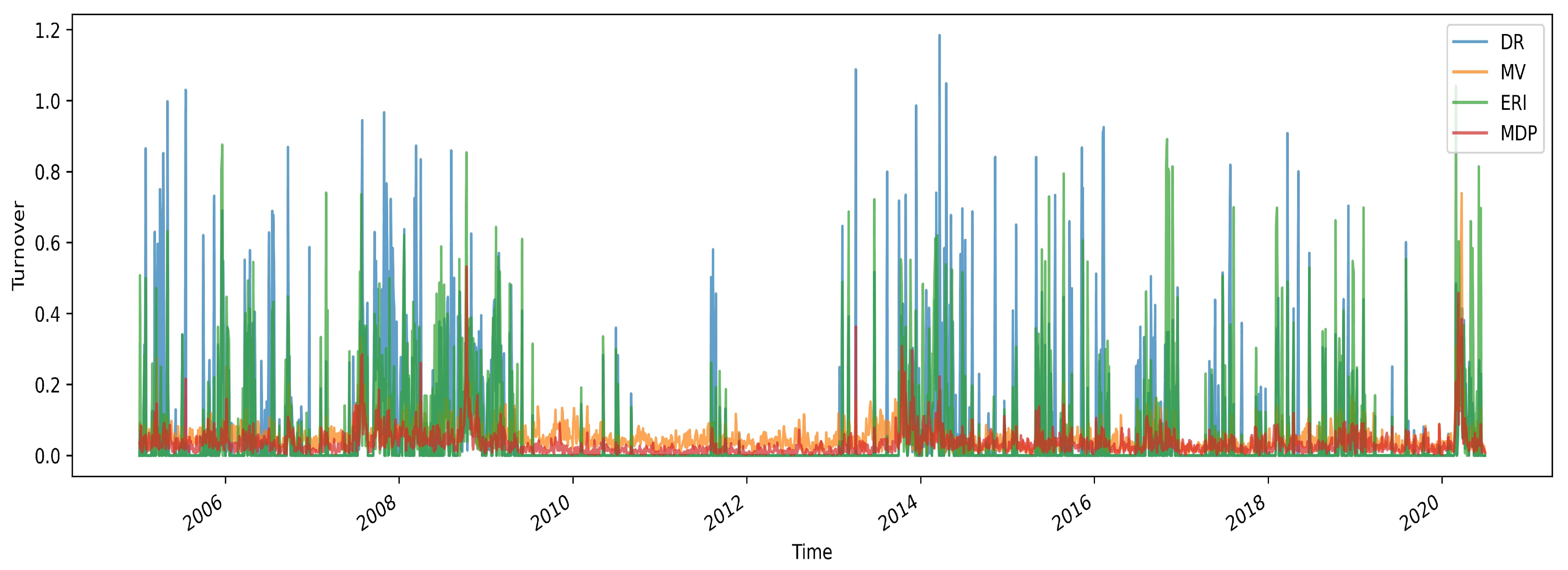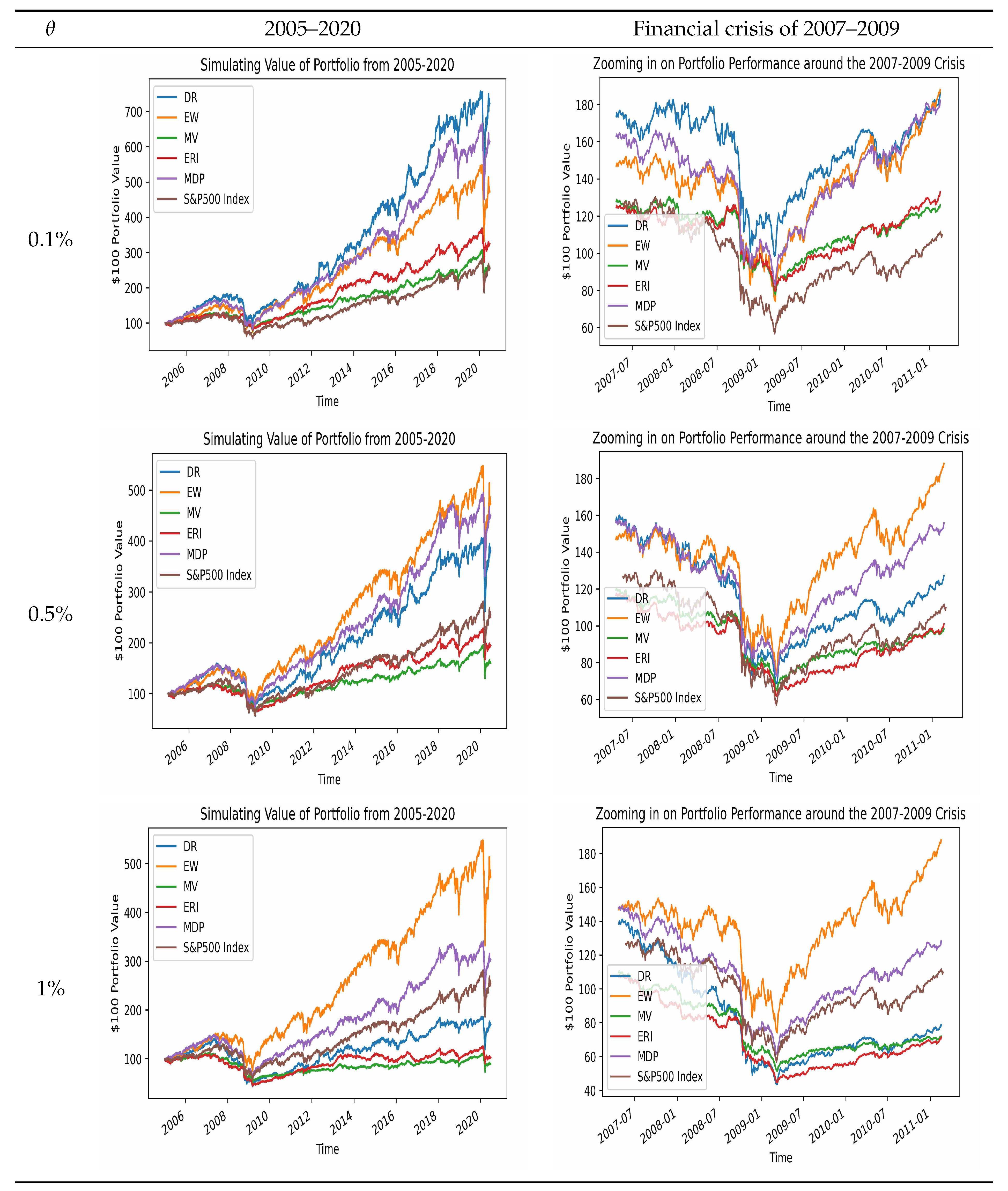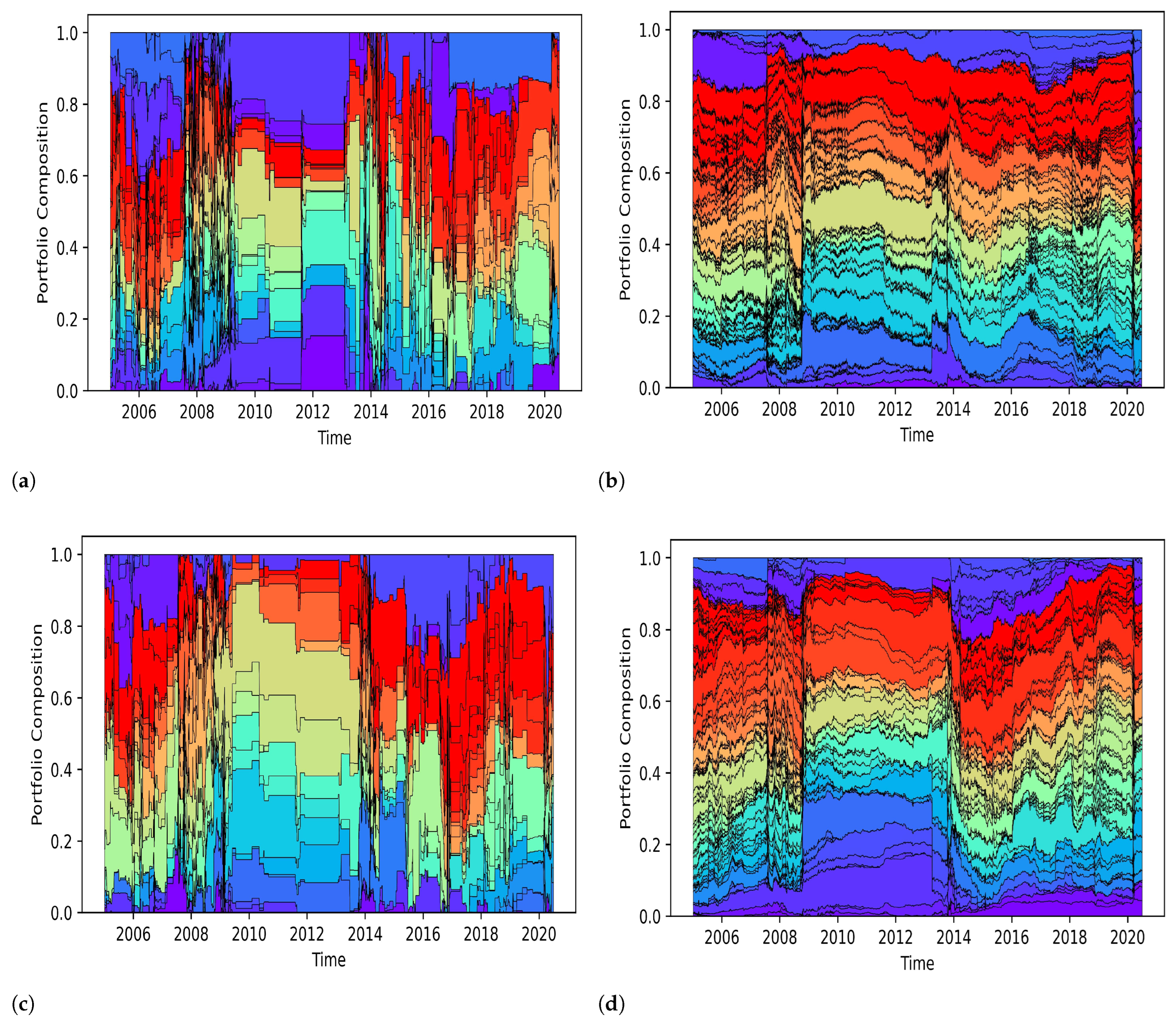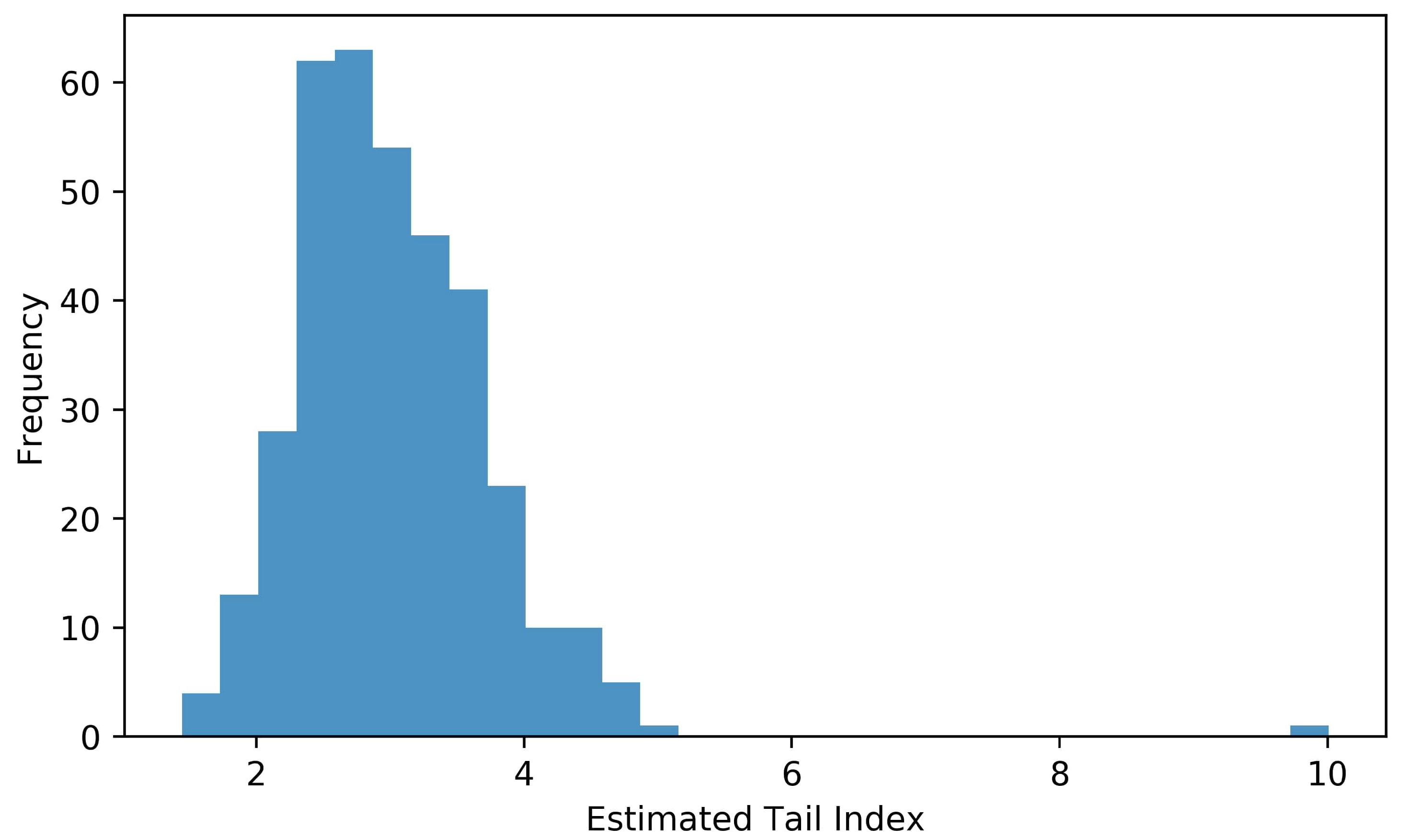In this section, we examine the performance of the portfolio that minimizes the DR. It is also compared with other four strategies, EW, MV, ERI, and MDP, together with the S&P 500 index. We first carry out the analysis by assuming all the 361 stocks follow a MRV model. Then we group the stocks with similar tail indices and analyze the performances of the five strategies for each group. Before the empirical study, we discuss the estimation method for DR portfolio and the backtest method.
By fitting the stock losses with the MRV model, the DR portfolio is estimated using the method introduced in
Section 2. To be more specific, we first calculate DR
using (
4), which is the limit of DR
by letting
q go to 1. The solution of minimizing DR
,
, is used to approximate the DR portfolio
. In the calculation of DR
, since only considering loss,
is estimated by
We perform out-of-sample tests to examine the robustness of the DR strategy. The DR is minimized on a 5-year rolling window. The backtest period is from 3 January 2005 to 29 June 2020. The rolling window is moved on alternate days and the portfolio is rebalanced on alternate days as well. For example, on 3 January 2005, the optimal weights are calculated based on previous 630 observations (5 years before 3 January 2005). There are a total of 2021 rebalancing dates in the backtest period. To calculate portfolio weights, we deploy sequential least-squares programming methods given an equal weight initialization. We restrict to no short selling and thus all the weights are non-negative and in between 0 and 1. The error margin is set as .
4.1. Analysis for All Stocks
We first carry out our analysis on all 361 stocks. When we apply the DR or ERI strategies, we fit the 361 stocks into a MRV model. This is a very rough fitting but some interesting results can be obtained. In the next subsection, a finer fitting is carried out for subgroups of the 361 stocks. This approach was also used in
Mainik et al. (
2015).
The portfolio values under all five strategies (DR, EW, MV, ERI, and MDP) together with S&P 500 index in the backtest period are plotted in
Figure 3. Although not directly implied by our theoretical results, the DR strategy overall has the highest portfolio value, especially during the financial crisis of 2007–2009 period and 2020 stock market crash due to the COVID-19 pandemic.
In
Table 2, we further compare the performance of the five strategies from different aspects. Subsequently, we discuss them individually.
The cumulative return (CR) is return over entire backtest period from 3 January 2005 to 29 June 2020 with alternate-day rebalancing. The annualized return (AR) annualizes CR by counting 126 alternate trading days in a year, and AR is calculated as
As seen from
Figure 3, with no surprise, the DR portfolio has higher CR and AR than the rest.
The Sharpe ratio is estimated by using the sample mean and sample variance for the alternate-day rebalanced portfolios. Since the risk-free return rate
is both difficult to estimate and close to 0, we approximate
for calculations. In
Table 2, the annualized Sharpe ratio is reported, which is approximated by multiplying the alternate-day Sharpe ratio with
. The MDP portfolio has the highest Sharpe ratio among all of the five strategies and this is much expected as MDP is diversifying away risks measured by the variance, which is the same measure used in the Sharpe ratio. Since our focus here is on extreme risks, standard deviation is not a good risk measure in this case. A modification of the Sharpe ratio, by replacing the standard deviation with Expected Shortfall (ES) risk measure, is better to capture extreme risks and hence a good performance metric in this context. More specifically, this modified Sharpe ratio, called
, is defined as
where
Z is the portfolio return and
is risk-free rate; see e.g.,
Rachev et al. (
2005). We let
and ES
is the expected shortfall risk measure at confidence level
. In empirical studies, we take
. The ES of a loss
Z is estimated as
where
are the order statistics. The annualized STARR ratio, reported in
Table 2, is obtained by multiplying alternate-day STARR ratio with
. DR has the highest annualized STARR ratio.
Maximum drawdown assesses relative riskiness of one strategy versus another. A low maximum drawdown indicate losses from investment were small. DR has a lower drawdown than EW, MDP, and the index. ERI having the lowest maximum drawdown is somewhat expected as it, by definition, minimizes aggregate risks of the portfolio.
Concentration coefficient (CC) for a strategy at time
t is defined as
where
is the optimal portfolio weights. For equally weighted portfolios, CC is maximized. When a portfolio concentrates on fewer stocks, the value of CC decreases. While CC ignores correlations in exposures, it is effective to capture risk appetite and stress levels with low computational complexity. In
Figure 4, CC is plotted for DR, MV, ERI, and MDP in the backtest period. Both DR and ERI have very low CCs over time and are very stable. MV and MDP have high CCs over the financial crisis of 2007–2009 and around 2018. This shows that the selection of stocks are related to the choices of the risk measures: especially during the crisis time, strategies (MV and MDP) using variance as the risk measure need more stocks to diversify away the risk while strategies (DR and ERI) using VaR need fewer stocks. The average CC over the backtest period is calculated for each strategy shown in
Table 2. Again, DR and ERI have similar but small CC suggesting they are selective in stocks.
The portfolio turnover is defined as
where
is the optimal portfolio weights. Turnover captures extent of re-balancing at each time-stamp by proxy on change in weights vector, and evaluates transaction costs of a strategy. In
Figure 5, the turnovers are plotted for DR, MV, ERI, and MDP in the backtest period. The average of turnover for each strategy is reported
Table 2. Both DR and ERI have higher turnover than other strategies.
From the above analysis, the VaR-based strategies (DR and ERI) have high turnover compared to the variance-based strategies (MV and MDP). This may be due to that VaR is more sensitive to extreme risks as opposed to variance taking both profits and losses into account. At the same time, DR and ERI have very low CCs, which means these strategies consist of fewer stocks. Thus, next we add the transaction cost to see if how low CC and high turnover affect the performance of these strategies. According to
Wrobel (
2017), from April 2007 to August 2008 the transaction cost increased
and from August to October in 2008 the transaction cost increased
, which is the highest levels in 5 years. That is the transaction cost during the financial crisis of 2007–2009 is higher than the normal time. For simplicity, we assume a constant transaction cost: the transaction cost per dollar amount traded is
during normal time, and the cost during the crisis time is
. That is the transaction cost is one and a half times of that in the normal time. Let
. The cumulative return with transaction cost is reported in
Table 2 and the corresponding portfolio values are shown in
Figure 6. When the transaction cost is as low as
, DR still outperforms other strategies due to its low CC. Once the transaction cost is higher (
), EW has the best performance and DR has the moderate performance because of its high turnover.
We further plot the optimal weights for DR, MV, ERI, and MDP at each rebalancing date during the backtest period in
Figure 7. The patterns of the optimal weights reinforce the observations in the study of the CC and turnover that DR and ERI consist of fewer stocks and have more significant changes in composition. They have similar patterns, i.e., frequent large changes in stock composition during crises (2008 financial crisis and 2020 stock market crash) and rather stable otherwise, while MV and MDP exhibit frequent but small changes in composition throughout. This difference should be attributed to the choice of risk measure. VaR is a measure to capture extreme risks better than variance so that both DR and ERI strategies are more sensitive in the crisis time, where extreme risks occur.
To analyze the degree of diversification, we perform principal component analysis (PCA) for each strategy. The first principal component is calculated on the weighted returns, that is for a
matrix
M, with
where
is the optimal weight and
is the log-return of the
jth stock at time
i. To account for temporal changes, we compute percentage of the sample variance explained by the first principal component on the first
i rows of the matrix
M at each time point
in the backtest period. The estimated percentage of variance is plotted over time in
Figure 8. We report the last percentage (
) in
Table 2. The smaller this value the greater the diversification. ERI has almost the smallest percentage of sample variance explained by the first principal component for majority of the time as showed in
Figure 8 and the smallest average value among all strategies although it has a low concentration coefficient. DR shows the smallest percentage after the 2008 crisis started. Similar pattern can be expected for the COVID-19 pandemic period. Although complete performance of the strategies over the pandemic are not shown here due to the time range of data, still we can conclude that DR is efficient in diversifying extreme risks and thus a feasible strategy in the period of a crisis.
The skewness and kurtosis of portfolio returns are reported as well. DR has a right skew while all the benchmark strategies have left skews. DR also has the highest kurtosis. This reinforces the findings in cumulative return and annualized returns that DR has the ability to generate higher risk-adjusted returns.
We ascertain DR’s distinctness with DR weights’ cosine similarity and DR returns’ Pearson correlation coefficient against other strategies in
Table 3. We observe low cosine similarities on DR weights coupled with high correlation on returns with other strategies. This dichotomy reinforces DR’s novelty in portfolio allocation since correlated returns hint at it capitalizing on similar temporal market movements as other strategies, while dissimilar weights (and higher returns) suggest it does so with an effective distinctive methodology.
4.2. Analysis of Grouped Stocks
In the previous section, all 361 stocks are fitted into a MRV model. In this subsection, we consider portfolios of stocks grouped with similar tail indices.
Figure 9 shows the distribution of the tail indices calculated by Hill estimator based on a 5-year window of alternate-day data from 1 January 2000 to 31 December 2004 for all 361 stocks. We divide these stocks into three buckets as shown in
Table 4.
The group of stocks with tail indices
contains the most heavy-tailed securities. The portfolio values for each strategy are plotted in
Figure A1 in
Appendix A. The portfolio values with transaction costs are plotted in
Figure A2. The performance of each strategy for this group of stocks is reported in
Table A1. DR has the moderate performance in returns. When the transaction cost is included, DR has low returns among the five strategies but it is still higher than ERI. DR has the lowest average percentage of sample variance explained by the first principal component. This shows that DR has highest significant effect of diversification for the most heavy-tailed stocks.
The group of stocks with tail indices
is by far the largest, with 195 listed securities. The portfolio values for each strategy are plotted in
Figure A3; the portfolio values with transaction costs are plotted in
Figure A4. The performance is reported in
Table A2. DR performs similar to that of the entire 361 stocks: it has highest cumulative return, annualized return, Sharpe ratio, STARR, and lowest average percentage of sample variance explained by the first principal component. When the transaction cost is low (
), DR still has the highest return rate due to low CC; however, when the transaction cost is higher, DR has moderate performance due to high turnover. This shows that DR works well for a vast majority of our securities universe.
The group of stocks with tail indices
contains the most light-tailed stocks. The portfolio values for each strategy are plotted in
Figure A5 and the portfolio values with transaction costs are plotted in
Figure A6. The performance is reported in
Table A3. Again, DR has the lowest average percentage of sample variance explained by the first principal component, reflecting the most significant effect of diversification. When transaction cost presents, DR has moderate performance.
To summarize, DR has highest effect of diversification in all three groups of stocks. It performs the best for most of the stocks with tail indices .
